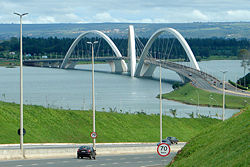
Juscelino Kubitschek bridge
Encyclopedia




Lake Paranoá
Paranoá Lake, or Lago do Paranoá, is an artificial lake located in Brasília, the capital of Brazil. On the east side of the city, the Paranoá River has been dammed to form this large lake, which has a circumference of...
in Brasília
Brasília
Brasília is the capital city of Brazil. The name is commonly spelled Brasilia in English. The city and its District are located in the Central-West region of the country, along a plateau known as Planalto Central. It has a population of about 2,557,000 as of the 2008 IBGE estimate, making it the...
. It links the southern part of the lake, and St. Sebastian Paranoá the Pilot Plan (or the central and original part of the city), through the Monumental Axis
Monumental Axis
The Monumental Axis is a central avenue in Brasília's city design.The avenue begins on the National Congress of Brazil building and is considered part of the DF-002 road. Its first section is known as "Ministries Esplanade" , as it is surrounded by ministries buildings...
. Inaugurated on December 15, 2002, the structure of the bridge has a total length of 1200 metres (3,937 ft), a width of 24 metres (78.7 ft) and two carriageways with three lanes in each direction, two walkways on the sides for cyclists and pedestrians 1.5 metres (4.9 ft) wide, and three spans of 240 metres (787.4 ft).
It is named for Juscelino Kubitschek de Oliveira
Juscelino Kubitschek de Oliveira
Juscelino Kubitschek de Oliveira , known also by his initials JK, was a prominent Brazilian politician of gypsy Czech origin who was President of Brazil from 1956 to 1961. He was born in Diamantina, Minas Gerais, and died in 1976...
, former president of Brazil
President of Brazil
The president of Brazil is both the head of state and head of government of the Federative Republic of Brazil. The president leads the executive branch of the federal government and is the commander-in-chief of the Brazilian Armed Forces...
, who in the late 1950s decided to build Brasília as the new capital of the country. It was designed by architect Alexandre Chan
Alexandre Chan
Alexandre Chan is an architect who designed the President Juscelino Kubitschek Bridge in Brasilia with structural engineer Mario Vila Verde. According to Architecture Week, Chan's idea for the bridge was to create a landmark for the enjoyment of the community as much as to simply traverse a body of...
and structural engineer Mário Vila Verde.
The main span structure has four supporting pillars submerged under Lake Paranoá, and the deck weight is supported by three 200 feet (61 m) asymmetrical steel arches that crisscross diagonally. The decks are suspended by steel cables alternating at each side of the deck, interlacing in some kind of twisted plane (parabolic like). The entire structure has a total length of 1200 metres (3,937 ft), and it was completed at a cost of US$56.8 million (R$160 million - Brazilian Reais
Brazilian real
The real is the present-day currency of Brazil. Its sign is R$ and its ISO code is BRL. It is subdivided into 100 centavos ....
, current 2003). The bridge has a pedestrian walkway and is accessible to bicyclists and skaters.
Awards
Despite the structural design complexity and the higher cost of the chosen solution, these characteristics give the bridge a great architectonicArchitectonic
Architectonic may mean:*pertaining to architecture, or suggesting the qualities of architecture*in Aristotelianism, as well as Kantianism, systematization of all knowledge...
al beauty and grandiosity, up to the level of Brasilia’s majestic scale. Inaugurated on December 15, 2002, this bridge immediately became one more of Brasilia’s favorite landmarks, especially at night. Chan won the Gustav Lindenthal
Gustav Lindenthal
Gustav Lindenthal was a civil engineer who designed the Hell Gate Bridge among other bridges.Lindenthal's work was greatly affected by his pursuit for perfection and his love of art. His structures not only serve the purpose they were designed for, but are aesthetically pleasing to the public eye...
Medal for this project at the 2003 International Bridge Conference in Pittsburgh
Pittsburgh, Pennsylvania
Pittsburgh is the second-largest city in the US Commonwealth of Pennsylvania and the county seat of Allegheny County. Regionally, it anchors the largest urban area of Appalachia and the Ohio River Valley, and nationally, it is the 22nd-largest urban area in the United States...
. This medal is awarded "for a single, recent outstanding achievement showing harmony with the environment, aesthetic merit and successful community participation".
This bridge was also awarded the "Premio Abcem 2003" (ABCEM Award) – Best Steel Work of the Year, Bridges and Highway Overpasses Category, granted by the Brazilian Metal Construction Association (Associação Brasileira da Construção Metálica, ABCEM).
The bridge architectural design looks similar to a pedestrian walkway in the Port of Nagoya Public Aquarium located at 35°05′25"N 136°52′47"E. However architectural design also included structure shapes and solutions that step away from that footbridge.
Dimensions
The main characteristics of the structure are:- Total length: 1,200 m
- Deck Width: 24 m (three lanes in each direction)
- Lateral sideways for pedestrians and bicycles: 1.5 m (on each side)
- Rise: 60 m
- Clearance: 18 m
- Arch span: 240 m for each of 3 spans

